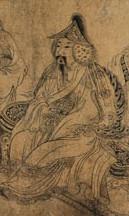Toghan Timur
Toghan Timur ( Ukhaatu Khan , Mongolian ᠲᠤᠭᠬᠣᠣᠨᠲᠥᠮᠥᠷ , * 1320 ; † May 23, 1370 in Yingchang on the banks of the Dalai Nur , today's administrative area of Sum Darhan Ul ( 达 日 罕乌拉 苏木 ) in the witches banner of the city of Chifeng in Inner Mongolia ) was a Mongolian khagan and under the name Huizong ( 惠 宗 , Huìzōng , posthumously Shundi 順帝 ) emperor of the Yuan dynasty . His reign began in 1333 and ended with the expulsion of the Mongols from Beijing in 1368.
Origin and accession to the throne
The last Mongol ruler of China was the son of Qoshilas with a woman from the Karluken tribe . He was born in exile. His uncle, Toqa Timur (r. 1328–1332) and his wife Budashiri , however, had it declared for years that he had only been adopted by Qoshila in order to boycott the boy's claims to the throne. They also exiled him to Korea and then to Guangxi .
But Putashali's candidates for the succession to the throne, Aratnada and Irinchinbal died in 1331 and 1332, and so after lengthy negotiations he had to be recognized as emperor for lack of selection. The de facto regent El Temür in particular resisted Toghan Timur's accession to the throne, and only after his death could he ascend the throne at the age of 13.
Chancellorship of Bayan and Toghta
Toghan Timur spent his time hunting, rituals including ritual sex practices, and mechanical constructions in the palace garden (he apparently had mechanical knowledge). The government was led by his chancellors: first Bayan (executed in 1340), then his nephew Toghta (ruled with interruptions until the end of 1354, murdered in 1356). Both pursued opposing policies: Bayan represented the Mongolian point of view (including renewed abolition of the official examinations in 1335) and Toghta pursued a policy of appeasement towards the Chinese (official examinations, tax breaks, sewer construction, etc.), which ultimately remained just as unsuccessful. The deposition of Toghta led to the rapid decline in power of the center or the dynasty, instead warlords (especially Cayan Timur and his adoptive son Köko Timur in Taiyuan , and Bolod Timur) took control of the north.
Red Turbans Revolt
The pent-up problems (weak currency, bandits, floods of the Huang He ) erupted in 1352 in the uprising of the Red Turbans , which shook the country and brought Zhu Yuanzhang, who later became Emperor Hongwu, to power in Nanjing in 1356 . Zhu Yuanzhang broke with the ideas of the red turbans, eliminated his opponents among the rebels and founded his own dynasty (see Ming dynasty ). After initial successes, the Mongols might have been able to stay in northern China, but were so demoralized that they also fought among themselves from 1360 onwards. Toghan Timur played a passive puppet role and was used by the warlord Bolod Timur (his father-in-law) against his son and heir to the throne Ajurchiridhara .
End of government
In 1368 the Ming troops conquered Beijing, Toghan Timur died while retreating north. His sons Biligtü Khan Ayushiridara (reigned 1370-1378) and Uskhal Khan (reigned 1378-1388) fled to Karakorum .
literature
- Michael Weiers: History of the Mongols. Kohlhammer, Stuttgart et al. 2004, ISBN 3-17-017206-9 .
- Timothy Brook : The Troubled Empire. China in the Yuan and Ming Dynasties. Harvard University Press, 2010, ISBN 0-674-07253-7 (English).
- Herbert Franke , Denis Twitchett : The Cambridge History of China Vol. 6: Alien regimes and border states 907-1368. Cambridge University Press, Cambridge 1994 (English).
- Frederick W. Mote, Denis Twitchett (Eds.): The Cambridge History of China. Vol. 7, The Ming Dynasty, 1368-1644, Part I. Cambridge University Press, Cambridge 1988, ISBN 0-521-24332-7 . (engl.)
- Jeremiah Curtin: The Mongols. A history. Greenwood, Westport / Conn 1972 (English, reprint of the original edition from 1908)
| predecessor | Office | successor |
|---|---|---|
|
Irinchibal ( 寧宗 , Níngzōng ) |
Emperor of China 1333–1368 |
Hongwu ( 洪武 , Hóngwǔ ) |
| Irinchibal |
Khagan of the Mongols 1333-1370 |
Biligtu Khan |
| personal data | |
|---|---|
| SURNAME | Toghan Timur |
| ALTERNATIVE NAMES | Ukhaatu Khan; Huizong |
| BRIEF DESCRIPTION | last emperor of China from the Yuan dynasty |
| DATE OF BIRTH | 1320 |
| DATE OF DEATH | May 23, 1370 |
| Place of death | Yingchang |
